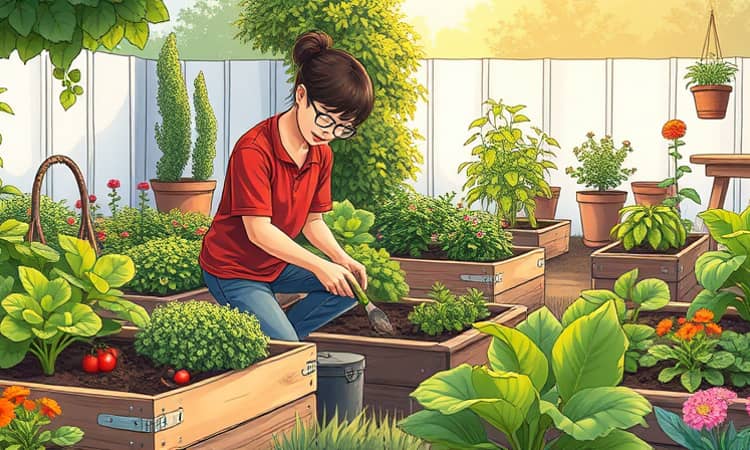Embarking on your first home gardening journey can be both exciting and a little daunting. With so many options—traditional in-ground plots, raised beds, containers, vertical towers—the possibilities are endless. This guide walks you through every step, from planning your garden layout to nurturing thriving plants, so you can cultivate fresh produce and beautiful blooms in your own backyard or balcony.
Planning Your Garden
Careful planning is the foundation of any successful garden. Before grabbing your shovel, take time to evaluate your space, resources, and ambitions. Whether you have a sprawling yard or a modest patio nook, measuring and sketching out your space helps you visualize plant placement and optimize sunlight exposure.
Starting early in spring gives you a head start, but you can begin designing and gathering supplies months ahead. Keep a garden journal to document successes and failures to help plan future seasons. This gradual approach builds confidence and ensures you learn from every seed sown.
- Begin with a manageable area, such as a 10' x 10' plot.
- Create a simple layout sketch, marking sun and shade patterns.
- Decide between in-ground, raised bed, or container setups.
- Plan pathways for easy access and maintenance.
Essential Gardening Tools
Equipping yourself with the right tools can transform garden chores from tedious to enjoyable. Investing in quality implements ensures they last and makes your work more efficient. Aim to assemble a kit that covers basic digging, cutting, and planting tasks.
- Garden hoe with long handle for weeding and soil turning.
- Rake and garden shovel to level soil and dig planting holes.
- Hand tools—trowel, mini rake, and hand hoe—for tight areas.
- Pruners and a gardening knife for precise trimming and harvesting.
- Gardening gloves to protect your hands from blisters.
- Plant stakes or tomato cages for supporting climbing crops.
When selecting tools, look for comfortable handles that fit your grip and consider blades made from hardened steel. It’s wise to keep tools sharp, clean, and sterilized to prevent disease spread and maintain efficiency.
Soil Preparation
Your soil is the lifeblood of the garden. Healthy, fertile soil yields vigorous plants and reduces pest and disease issues. Start by testing pH and nutrient levels through a local extension service or home kit. Most vegetables thrive near pH 7, but some flowering plants prefer slightly acidic conditions.
Improve your soil by amending with organic matter—compost, aged manure, or leaf mold. This boosts structure and nutrient content while enhancing water retention and drainage. Incorporating mulch after planting helps maintain moisture, suppress weeds, and gradually enrich the soil as it breaks down.
Plant Selection for Beginners
Choosing the right plants can make your first season more rewarding. Focus on hardy, forgiving varieties that bounce back from occasional neglect. Look for low-maintenance, resilient plants suited to your USDA hardiness zone and sun exposure. Perennials like daylilies, hostas, and ornamental grasses return year after year, offering color without constant replanting.
For edible gardens, start with fast-growing vegetables such as radishes, leaf lettuce, and green beans. Herbs like basil, chives, and mint are also excellent starters; they thrive in containers and require minimal care.
Planting Techniques
Proper planting methods set the stage for healthy growth. Dig holes twice as wide as the root ball but no deeper, ensuring the crown stays level with the soil surface. Space seedlings according to packet instructions to allow for adequate air circulation.
Group plants by water needs. Combining thirsty crops like tomatoes in one section and drought-tolerant herbs in another simplifies irrigation routines. If space is limited, vertical gardening with trellises or stackable planters maximizes yield and creates visual interest.
Garden Maintenance
Once your garden is planted, establish a regular care schedule. Consistency is key to preventing small issues from becoming major headaches. Check for pests early and remove weeds before they spread. Mulching not only conserves moisture but also keeps unwanted seedlings under control.
- Water deeply and infrequently to encourage strong roots.
- Inspect plants weekly for pests, diseases, and nutrient deficiencies.
- Prune spent blooms to stimulate new growth and extend flowering.
- Rotate crops annually to prevent soil-borne diseases.
As you gain experience, gradually expand your planting area and experiment with new varieties. Keep observing and adapting—your garden will flourish under attentive care.
Seasonal Considerations
Gardening is a year-round hobby. In early spring, prepare beds by clearing winter debris and testing soil. Late spring and summer bring rapid growth—stay on top of watering and weeding. As fall approaches, harvest remaining crops and amend beds with compost for winter rest.
In colder climates, consider cold frames or hoop houses to extend your growing season. Mulching beds heavily in late fall protects soil life and preserves moisture for spring planting.
Garden Types and Layouts
Home gardens come in many forms. Traditional in-ground beds suit large spaces with quality soil. Raised beds offer improved drainage and ease of access, while container gardens thrive on patios or balconies. Vertical systems—trellises, netting, and pocket planters—let you grow more in less space, perfect for urban dwellers.
Design your layout with paths wide enough for a wheelbarrow or garden cart. Incorporate seating areas or focal points like a birdbath or decorative planter to create an inviting outdoor room.
Knowledge Building Resources
Continuing education fuels gardening success. Keep a detailed journal of planting dates, weather conditions, and harvest yields. Note both triumphs and challenges to refine your strategy. Explore local gardening clubs, community gardens, and extension workshops to learn region-specific tips.
Online forums and plant databases can help diagnose problems and inspire new projects. With each season, your confidence will grow alongside your garden.
By following these guidelines—starting small, choosing the right tools, enriching your soil, and staying dedicated—you’ll soon enjoy the satisfaction of homegrown vegetables and flowers. Gardening isn’t just a hobby; it’s a lifelong journey toward connection with nature and personal growth.
References
- https://www.almanac.com/vegetable-gardening-for-beginners
- https://www.yougrowgirl.com/resources/beginner-gardening-guide/
- https://www.thespruce.com/beginner-gardening-8600881
- https://www.fbfs.com/learning-center/how-to-start-a-garden-a-beginners-guide
- https://naturehills.com/blogs/garden-blog/complete-beginner-s-guide-to-gardening-easy-plans-and-plants
- https://ucanr.edu/site/uc-marin-master-gardeners/essential-tools
- https://fromsoiltosoul.ca/complete-raised-bed-gardening-guide-for-beginners/
- https://www.gardeningknowhow.com/garden-how-to/info/beginners-guide-to-gardening.htm














